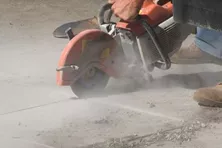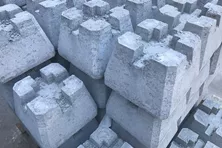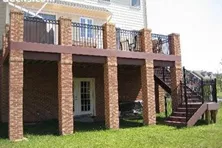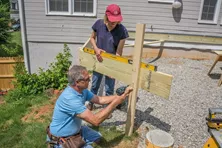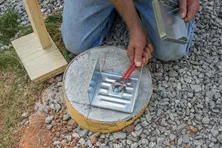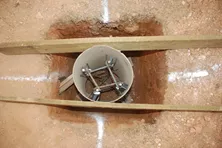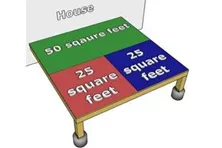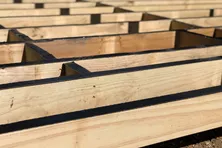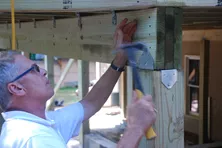Soil Conditions For Deck Footings
Before you can calculate the size of your footings, you will need to know what kind of soil is present in your yard. Most soils can be classified into three categories: gravel, sand and clay.
Gravel: This type is primarily composed of small stone pebbles that you can see easily with the naked eye. Gravel feels rocky. You cannot roll this soil into a ball. Gravel will drain water very easily and can support the greatest amount of load (3000 lbs/sq ft).
Sand: Sand is composed of tiny particles that are difficult to see with the naked eye. Most sand is tan or white in color. Sand has a rough gritty texture. If you try to roll sand into a ball, it will not hold its shape. If you add water to sand, it will run through very quickly. Sand can support a load of 2000 lbs/sq ft.
Clay: You cannot see clay particles without a strong magnification. Clay feels sticky and can easily be rolled into a ball. It doesn’t drain water very easily. Clay can be many different colors depending on what other minerals it is mixed with. It is the weakest common soil type supporting a load of 1500 lbs/sq ft.
If you are unsure what soil type you will be working with, always use the worst case scenario, which is clay, to make your calculations.
Cutting a Concrete Pad
Learn how to use a concrete saw to cut a hole in a patio slab to install a deck footing.
Can I use pier blocks?
Our inspector explains the pros and cons of using pier blocks for deck foundations.
Buried Post
Learn how to install a concrete deck footing with a buried treated support post as an alternative to a solid pier foundation.
How to Decorate Deck Support Columns
Browse some examples of decorative deck support posts for tall decks.
Determining Deck Beam Height
Learn how to measure in order to set your posts to properly position your deck beam to the correct height. We recommend sloping your deck to shed water away from the house.
How to Brace a Swaying Deck
Learn how to install a diagonal brace on your deck frame to prevent racking. Check out our detailed image.
More Helpful Resources
Explore Articles by Topic

Footings
Information related to installing frost footings for decks

Framing
Learn structural framing methods

Decking
Learn about wood and composite decking materials

Stairs
An in-depth look at the complex issue of how to build stairs

Railings
How to install guardrails and handrails to meet IRC code

Features
An overview on water drainage, benches, planters and lights

Design
The basics of deck design

Planning
Learn about permits and working with contractors

Porches & Patios
Build a covered deck to enjoy all seasons

Ledger
Proper attachment techniques

Care
Maintain your deck to maintain your investment

Materials
An overview on water drainage, benches, planters and lights
How many footings do I need?
Learn how to determine the number of footings and support posts you need for your deck when designing your deck frame.
Protecting From Collapse
Learn how to use cardboard sonotubes and hole covers to protect your deck footing holes from caving in and flooding before pouring concrete.
Footing Size
Learn how large to make your deck footings. Use our table for maximum allowable loads to determine the proper size for your soil type.
Why is Joist Protection so Important for Your Deck?
If you’ve ever seen a piece of wood left out in the weather for any period of time, you know what happens: decay. Whether through wet rot, insect damage, or mildew, the fibers begin to break down.
Deck Joist Cantilever & Overhang Rules
Learn what factors determine the maximum joist cantilever overhang that is allowed.
How to Use a Triple Deck Beam to 6x6 Post Connection
Learn how to use a post beam connector to attach a 3-2x10 beam to a support post for a deck when there isn't enough material on the post to create a notched connection.
Explore Articles by Topic

Footings
Information related to installing frost footings for decks

Framing
Learn structural framing methods

Decking
Learn about wood and composite decking materials

Stairs
An in-depth look at the complex issue of how to build stairs

Railings
How to install guardrails and handrails to meet IRC code

Features
An overview on water drainage, benches, planters and lights

Design
The basics of deck design

Planning
Learn about permits and working with contractors

Porches & Patios
Build a covered deck to enjoy all seasons

Ledger
Proper attachment techniques

Care
Maintain your deck to maintain your investment

Materials
An overview on water drainage, benches, planters and lights





